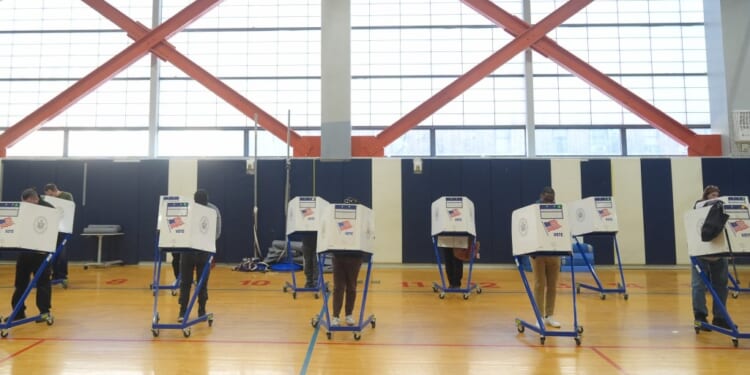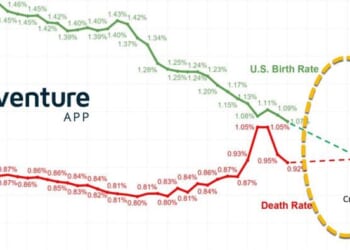
Hours after democratic socialist Zohran Mamdani secured New York City’s mayoralty with 50 percent of the vote, White House deputy chief of staff Stephen Miller posted a lone screenshot. The image, pulled from a NYC.gov webpage titled “Family Household Types by Immigration Status,” began simply: “Almost 50 percent of New Yorkers live in households with at least one immigrant.” Miller had clearly identified his culprit.
Former White House Chief Strategist Steve Bannon made the thesis explicit hours later, stating in an interview: “You’re going to see a whole new group of Mamdanis in these major urban cities because they’re just flooded with immigrants, right? That’s where his vote came from, principally.”
It is hardly surprising that figures like Miller and Bannon have rushed to pin responsibility for Mamdani’s win on immigrant voters and their descendants. Under the most charitable interpretation, it is more comforting for some conservatives to attribute socialism’s rise in popularity to an influx of foreigners rather than to shifts in opinion among American youth. Their claims also carry surface-level plausibility: An exit poll showed Mamdani did win 86 percent of voters who had lived in New York less than five years.
The theory that immigrant support is behind Mamdani’s rise has gained steam online in part because analysts with differing views are reluctant to challenge it. Many progressive writers still hope that their movement remains a rainbow coalition of the ascendant—proudly including immigrants—that will soon send the Republican Party to the demographic ash heap of history. Others of varying political stripes are uncomfortable seriously tackling restrictionist arguments about demographic replacement, since that would require validating what they see as a xenophobic premise.
Yet even a surface-level analysis of recent voting patterns severely complicates both restrictionist fears and progressive hopes about the trajectory of immigrant voters.
What the New York City election actually shows.
Immigrant support alone could not have secured Mamdani’s victory over former New York Gov. Andrew Cuomo.
The best estimate we have of how voters cast their ballots as of November 9, 2025, is a CNN exit poll. While the poll did not specifically survey immigrant voters and their descendants, a few measures can be reasonably used as proxies.
For example, some commentators have focused on the breakdown of voters by how long they have lived in New York, even though this group is likely largely made up of native-born citizens. Even with that caveat, recent arrivals to New York City (those living there 10 years or fewer) constituted only 14 percent of the electorate, according to the poll of 4,744 respondents. Within this group, Mamdani secured 82 percent support compared to Cuomo’s 16 percent, generating approximately 11.4 percentage points of Mamdani’s 50-point total. This represents a substantial overperformance relative to group size but hardly constitutes electoral determinism. The remaining 78 percent of Mamdani’s vote, or roughly 39 percentage points, came from voters who had lived in New York more than a decade or were born in the city.
The single largest residential category of voters were those born in New York City, at 45 percent of the electorate, according to the exit poll. Mamdani won 39 percent of this group, compared to Cuomo’s 48 percent. If Cuomo had won an authoritative majority of 68 percent of these voters instead of barely mustering the support of a plurality, he theoretically would have won the election outright. Instead, in absolute terms, native-born New Yorkers provided approximately 17.5 percentage points of Mamdani’s 50-point total—more votes than those who had lived in the city 10 years or less.
This pattern contradicts the foundational premise of immigrant electoral transformation. If recent immigration had fundamentally reshaped the electorate to enable Mamdani’s victory, he would have performed much more poorly among the native-born. But more than one-third of lifelong New Yorkers supported him, delivering his second-largest vote bloc after longer-term residents who had lived in the city more than a decade.
Moreover, the 45 percent born in New York includes second-, third-, and fourth-generation descendants of immigrants alongside descendants of colonial and pre-industrial-era settlers. In a city that has had high amounts of immigration since the 1800s, defining who qualifies as an “immigrant descendant” is an analytically meaningless exercise. The category could expand to encompass nearly everyone or contract to include almost no one, depending on the definer’s objectives. For example, Mamdani fared very poorly with Jewish New Yorkers, the bulk of whom could fairly be characterized as a recent-immigrant-descendant voting group.
The real drivers of Mamdani’s coalition.
Age, not immigration status or descent, explains the electorate’s response to Mamdani. Voters aged 18-29—16 percent of the electorate in the exit poll—gave him 75 percent support, contributing 12 percentage points to his total. Those aged 30-44—24 percent of voters—provided 65 percent support, adding 15.6 points. Combined, voters under 45 years of age delivered nearly half of Mamdani’s points despite representing just 35 percent of the electorate. Voters 65 and older, by contrast, gave him only 34 percent of their vote, or 8.8 percent of his final total support, while constituting 26 percent of all voters.
This generational divide transcends immigration patterns. If we take ethnicity as a proxy and assume most Latino voters are descendants of relatively recent immigrants or immigrant voters themselves, it becomes clear that age is still the more relevant factor. Young voters across all demographic groups strongly supported Mamdani, according to the exit poll, while older voters across all groups were skeptical. White voters aged 18-29 gave Mamdani 62 percent; black voters 18-29 gave him 83 percent; Latino voters 18-29 gave him 84 percent.
Meanwhile, white voters 65 and older gave him just 29 percent; black voters 65 and older gave him 44 percent; Latino voters 65 and older gave him 40 percent. In other words, older Latino voters were much, much closer in their voting patterns to older white voters than they were to younger Latino voters.
Education was the other big divide. College graduates, 60 percent of the exit poll electorate, supported Mamdani at 57 percent compared to 38 percent for Cuomo, contributing 34 of Mamdani’s 50 points. Those with advanced degrees gave him 56 percent support. Non-college voters provided 42 percent support, delivering 16 points.
The national picture: Immigrant voters have moved rightward.
The New York-specific analysis negates Bannon’s claim that immigrants were “principally” behind Mamdani’s victory, but recent national data reveals an even deeper flaw with the restrictionist narrative that immigrants drive progressive wins. Immigrant voters in 2024 moved decisively toward Republicans, not toward democratic socialists. If immigration inevitably produces waves of Mamdani-style victories in “major urban cities” as Bannon warns, we would expect high-immigrant jurisdictions to demonstrate leftward movement. The opposite has occurred.
Several major high-immigrant counties in the United States shifted sharply rightward from 2020 to 2024. Miami-Dade County, the only U.S. county with a foreign-born majority at 54.3 percent, flipped Republican in a presidential election for the first time since 1988, delivering 55.2 percent of the vote to Donald Trump versus 43.8 percent to Kamala Harris. The swing rightward was even stronger in heavily immigrant areas. Hialeah, Florida, the nation’s most heavily immigrant city at 74.6 percent foreign-born, voted overwhelmingly Republican.
This trend was also replicated in heavily immigrant metro areas that did not flip for Trump in 2024. Los Angeles County, with the nation’s largest immigrant population in absolute terms, remained Democratic at 64 percent for Harris but experienced a 14-point margin reduction from Joe Biden’s 2020 performance. Queens County, New York, stayed Democratic, giving Harris 62 percent of the vote, but demonstrated a 10-plus point rightward swing.
Nationwide, naturalized citizens (the only immigrant group eligible to vote) split nearly evenly at 51 percent for Harris to 47 percent for Trump, compared to 59-38 percent for Biden in 2020. According to an analysis by Pew, in 2024, 55 percent of white naturalized citizens voted for Trump (compared with 41 percent in 2020), as did 51 percent of Hispanic naturalized citizens (up from 39 percent in 2020) and 46 percent of Asian naturalized citizens (an increase from 35 percent in 2020).
Economic anxiety is a key driver for immigrant voters, just as with native-born voters. Concerns about inflation, grocery prices, and housing costs are much more important to them than identity-based appeals. Given how clear the evidence for this is based on the last presidential election cycle, restrictionist claims about “electoral replacement” should be dead on arrival. Instead, they are still being pushed as if the 2024 election didn’t happen.
Why the narrative persists despite contradicting evidence.
The “demographic destiny” narrative is resilient despite clear and disqualifying empirical evidence to the contrary because it satisfies multiple political needs simultaneously. For restrictionists, it provides apparent justification for aggressive immigration enforcement. If newcomers install radical candidates, then doing whatever it takes to slow their arrivals is justifiable in order to prevent such outcomes. For progressives, the narrative offers a sense of triumphant inevitability. If immigration trends favor left-leaning candidates, then political transformation requires merely patience rather than persuasion. Both formulations treat voters as mechanistic products of origin rather than reasoning actors who shift their political support according to conditions and messaging.
Even in the most recent cherry-picked example, Mamdani won against a scandal-battered opponent in one of the most liberal cities in the country by assembling a coalition of young, educated, progressive voters who prioritized economic issues—not because immigration fundamentally transformed the electorate’s composition. Recent arrivals participated in this coalition but neither dominated it numerically nor distinguished themselves ideologically from native-born young progressives sharing similar economic circumstances and political outlooks.
The good news for restrictionists is that—as Trump’s success shows—winning immigrant voters or their descendants does not require taking more moderate positions on immigration, contrary to what many in both parties spent decades arguing. The good news for progressives is that the same economic conditions that drove immigrant voters away from their coalition could very well drive them back in the next presidential cycle. The good news for us all is that despite what these two groups would have us believe, we still live in a competitive democracy where most people vote based on what they see in their wallets instead of what they see in the mirror.
















